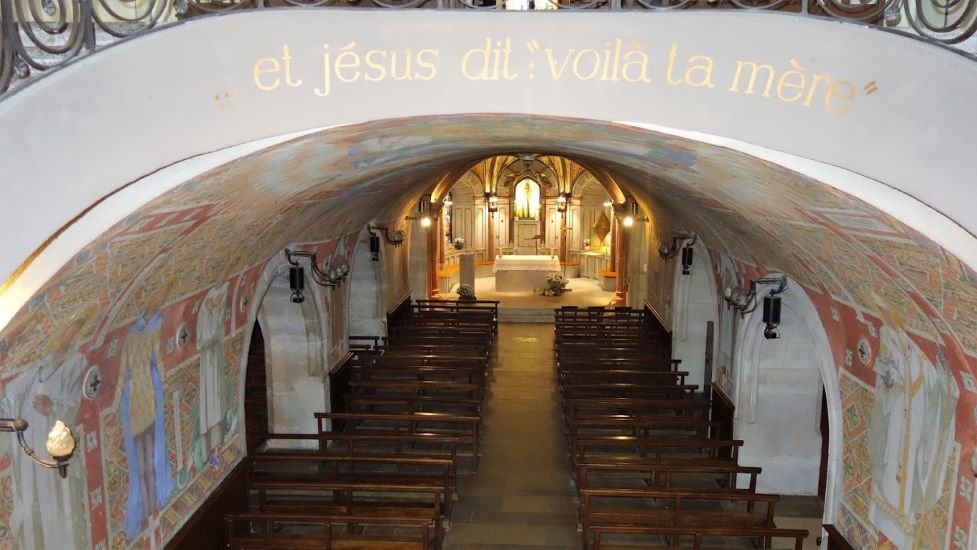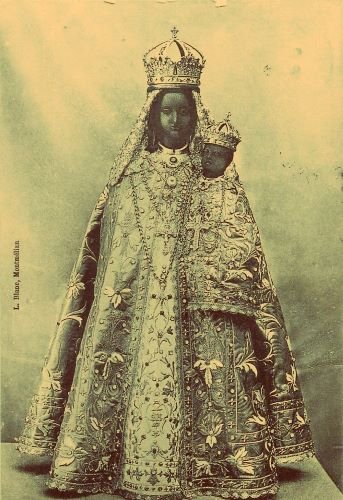Myans
The Black Madonna of Myans,
(la Vierge Noire de Myans)
Queen of Savoy
In the Sanctuary of Our Lady of Myans, 40 Route du Sanctuaire, 73800 Myans, about 1100 A.D., ebony wood, 70 cm/2’29” tall
by Anasuya Isaacs
Glorious Black Madonna!
This Black Madonna is venerated in the crypt under the Sanctuary of Notre Dame de Myans. Our Lady holds the holy child in her left arm as he sits on her lap. She is a “Seat of Wisdom” Virgin, very majestic. In 1619, the French historian François-Emmanuel Fodéré described her as “black Ethiopian” or “Black in the Ethiopian way” (noire en éthiopienne).[1]
Our Lady of Myans Sanctuary in Savoy is located on a little hill between Modane and Chambery near the Mont Cenis tunnel. You’ll know exactly when you reached the town because you will see the huge, golden statue of the Blessed Virgin standing atop the shrine’s belfry.[2]
The Upper Sanctuary, now known as Notre-Dame de Myans, is also known as The Golden Virgin of Myans. On the very top of the Sanctuary stands the most magnificent statue of the Blessed Virgin Mary in bronze coated in gold. She wears the crown of the Duke of Savoy, emblem of her sovereignty over Savoy. She is draped in the fashion of the 13th century, the time of the Mt. Granier disaster.[3]
I love the words that crown the beautiful stairway that descends into the crypt: “And Jesus says, ‘Here is your mother.’”
The golden Madonna on top of her church at the foot of the mountain whose giant bolders she stopped at her doorstep.
Photo: Florian Pépellin
MIRACLE OR LEGEND?
I read quite a bit about the miracle that happened on November 24, 1248 and found the fullest history on a French investigative reporting television show. Jeanne LeJeune, a Myanese woman, who has been working as Secretary to the Mayor for 30+ years, has been fascinated by the history of her Myans, a town nestled in the valley at the foot of Mont Granier near the Swiss border, and has done quite a bit of research.
In this interview LeJeune reveals what happened BEFORE the cataclysm. There was an Abby associated with the small chapel to the Black Virgin. Jacques Bonivart, a cleric for the Count of Savoy, made a deal to support the Pope against Frederick II Holy Roman Emperor, who was also the King of Italy, King of Germany, King of Sicily, King of Jerusalem and the King of Burgundy (which would become part of France). The Emperor had been ex-communicated by the Pope but was still operating like he had Papal authority. In exchange for his political and military support of the Pope, Bonivart asked for the gift of the Granier Benedictine Abbey of Apremont as an expression of the Pope’s gratitude. Bonivart then chased all of the monks out of the abbey to take possession of his new home. The Monks, not knowing where to go or what to do, fled to the chapel of the Black Madonna and prayed for her mighty and merciful protection.
That same night of November 24, 1248, while Bonivart and his cronies were celebrating their take-over of the abbey with a grand party, fully partaking of all of the good wine and eating like aristocrats, as the religious did during Feudal times, the ground began to tremble, the building began to shake. Bonivart and his cronies fled the abbey and took refuge in the Chapel of the Black Madonna right alongside the praying monks.[4]
The devastating earthquake shook the Savoy region, setting off an avalanche from Mont Granier. The Roman Catholic Church records describe the event as: “the tallest mountain of the Chartreuse Massif to disintegrate into huge boulders which came crashing down into the valley. Some of these boulders were the size of a house, and 16 villages were crushed and 5,000 lives lost. The church of Myans, however, was spared, though gigantic boulders stopped abruptly at the very door of the church.”[5] Ean Begg’s source adds: “The monks could hear the demons calling to each other ‘Go on! Go on! to be answered by their fellows, ‘We can’t because the Brown One, that is to say the Black One, is stopping us.’” (op. cit.)
Still, to this day, one can see the gigantic boulders that rolled near the door of the chapel without destroying it nor the town. Miraculously, everyone in Myans was spared by the protective benevolence of the Black Madonna.
When word spread across France that the Ebony Statue of the Virgin and Child from the 1100s saved the town of Myans from total destruction, the small chapel of the Black Virgin became a magnet of devotion.[6] From then on, people came to Myans to beg and plead to Our Lady for rescue, especially during times of tragedies, epidemics and plagues.[7]
the Black Madonna of Myans on her altar in the crypt
MOTHER OF MIRACLES
In 1534, Jean Grandis of Savoy was on a journey across the sea from Genoa to Leghorn in Tuscany, Italy. Suddenly a storm made the waters dangerous, threatening to sink the ship. Jean immediately started praying to the Black Madonna of Myans, Queen of Savoy to rescue him. Battered by the choppy waves, the ship capsized before sinking, Jean Grandis was the only survivor. To offer his gratitude to Our Lady for rescuing him, he walked in his bare feet from his home to the chapel of the Black Madonna to offer his ex-voto. His is considered to be one of the oldest ex-voto that is still where he left it.
There is another well-known miracle attributed to the Black Madonna of Myans involving the rescue of Count Louis de Sales, brother of Saint Francis de Sales. In 1603 The Count was traveling to the Chateau of Cusy to get married to Claudine Philiberte de Pingnon. In order to get to the chateau, The Count had to cross the Cheran River that had no bridge in sight! Arriving at a spot where he believed that the waters were more shallow than they actually were, the Count stepped in the river and immediately the flood waters swept him away. Calling on the Black Madonna of Myans for rescue, he promised to make a pilgrimage to her if he survived. Suddenly, he crashed into an obstruction that gave him the opportunity to pull himself out of the river and save his life. His wedding took place on April 2, 1603. The very next day, St. Francis de Sales offered Mass in the Chapel of the Black Madonna of Myans in honor and in gratitude for the miracle of saving his brother’s life.
This holy card from the collection of the Victoria & Albert Museum, London, was printed in 1903, for the commemoration of the tercentenary of this miracle, when Pope Pius X (1835-1914) recognised the miracle working prestige of Our Lady of Myans with a canonical coronation. The dedication says: “It’s at the feet of Our Lady of Myans that I leave the wishes for happiness, which I form for you.”
HISTORY OF THE CHURCH
According to old, historical texts written about Myans, the chapel is said to have been there since the year 1000.[8] It was the devastating tragedy of November 24, 1248 that put the small chapel with its miraculous Black Madonna (that was created sometime in the 1100s) in the prayers and minds of people all over France and beyond.
a lithograph of the original Black Madonna before she was damaged by revolutionaries
In 1452, the Franciscan monks began to build the church on top of the crypt where the chapel with the miraculous Ebony Virgin is worshiped. The monks lived in service and deep devotion to the church until 1792 when the French Revolutionaries attacked the church and badly damaged the Black Virgin. The restored statue was re-enshrined in the church crypt in 1855. [9] The church had to be restored at various times in the 19th and 20th centuries. The sanctuary is formed of two distinct places of worship, one superimposed upon the other. There is only one other church in the world with this kind of structure which can be found in Bethlehem.
The Virgin was canonically crowned on August 17, 1905 by decision of Pope Pius X who delegated Cardinal Couillé, Prelate of Gaules, Archbishop of Lyon, surrounded by five bishops and more than 20,000 faithful.[10]
In 1950, the statue of the Black Madonna was taken as the Ambassador of Savoy to Rome by a Savoyard pilgrimage for the definition of the dogma of the Assumption in the year 1950,[11] perhaps, imbuing in her increased holiness.
The Upper Sanctuary, now known as Notre-Dame de Myans is also known as The Golden Virgin of Myans. On the very top of the Sanctuary stands the most magnificent Statue of the Blessed Virgin Mary in bronze coated in gold, which was erected in memory of the collapse of Mount Granier and the miracle our Blessed Mother delivered in the town of Myans on October 17th, 1855.[12] Our Lady of Myans Sanctuary in Savoy is located on a little hill between Modane and Chambery near the Mont Cenis tunnel. You’ll know exactly when you reached the town because you will see the huge statue of the Blessed Virgin standing atop the shrine’s belfry.[13]
Jacques de Montmayeur decided to found a convent of the order of St. Francis in Myans, and the work of expanding the church was carried out in the first half of the 15th century. The upper church was consecrated in 1458, and the merging of the two sanctuaries was completed in 1498.[14]
In 1913, a campanile was built on the top of the church to house a carillon of 14 bells. The crypt was completely restored in 1936 (frescoes by Léon Raffin), the choir in 1972 and the upper church in 1978.
In the vault of the nave of the lower Church are painted ten unforgettable figures of the Saints and blessed of Savoy and Dauphiné, including St Francis de Sales (1567-1622) and St Louis of Savoy (1462-1508).
Our Lady of Myans is celebrated on September 8th, the Feast of the Nativity of the Virgin, and again on November 24th in remembrance of the miracle that happened in 1248. [15] Arnold van Gennep (1873-1957) calls this the “most ancient and stable pilgrimage in France”.[16]
Footnotes:
[1] Quoted in Ean Begg, The Cult of the Black Virgin, Arkana, England: 1985, p. 206
[2] The website of the sanctuary sanctuaire-nd-myans.fr/decouvrir/
[3] anastpaul.com/2021/11/24/vierge-noire-de-myans-the-black-madonna-of-myans-montmelian-chambery-france-1248-24-november/
[4] https://www.youtube.com/watch?v=2iYqPjhwn40&t=77s
[5] https://www.roman-catholic-saints.com/our-lady-of-myans.html
[6] https://anastpaul.com/2021/11/24/vierge-noire-de-myans-the-black-madonna-of-myans-montmelian-chambery-france-1248-24-november/
[7] The website of the sanctuary, op. cit.
[8] ibid
[9] https://anastpaul.com op. cit.
[10] https://sanctuaire-nd-myans.fr/decouvrir/
[11] https://www.roman-catholic-saints.com/our-lady-of-myans.html
[12] https://anastpaul.com op. cit.
[13] https://www.roman-catholic-saints.com op. cit.
[14] https://sanctuaire-nd-myans.fr/decouvrir/ op. cit
[15] https://anastpaul.com/2021/11/24/vierge-noire-de-myans-the-black-madonna-of-myans-montmelian-chambery-france-1248-24-november/
[16] Quoted in Ean Begg, op. cit.








